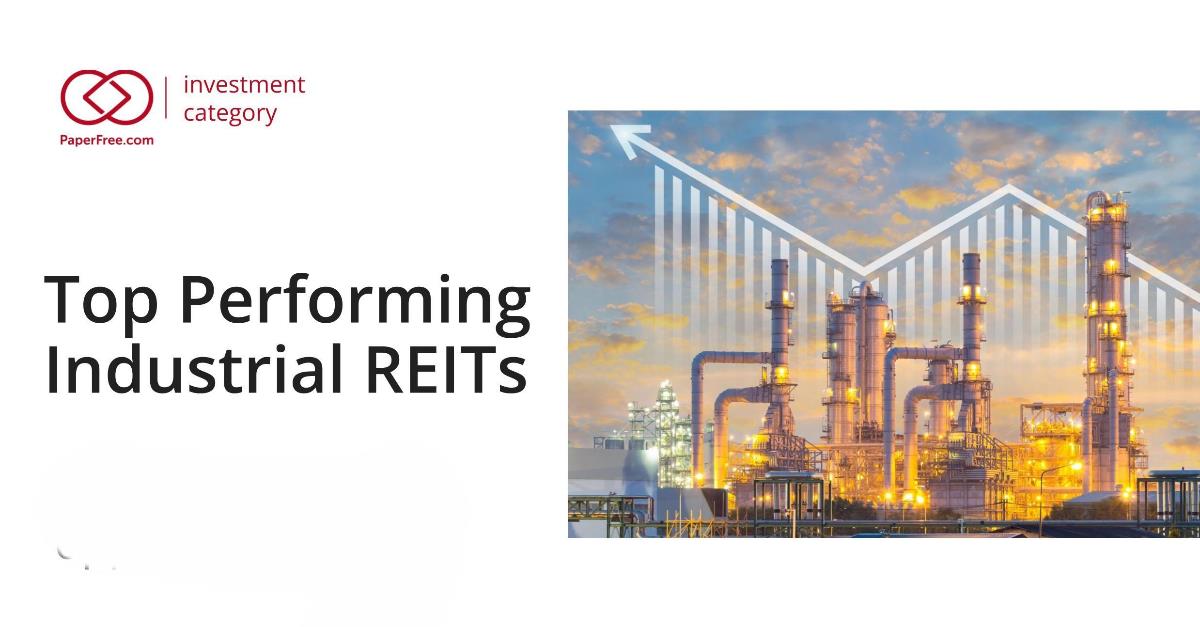Industrial REITs | Industrial Real Estate Investing. Real Estate Investment Trusts
Industrial Real Estate Investment Trusts (REITs) are your Gateway to Generational WealthFREE CONSULTATION

Investment Opportunities
Paperfree Marketplace Private Funds
Research News and Insights
| Sector | Industry | Sub-industry |
| Real Estate | Industrial REITs | Industrial REITs |
List of Industrial REITs
| REIT Name | Ticker | Market Cap (USD) | Dividend Yield | Focus Areas |
|---|---|---|---|---|
| Prologis Inc. | PLD | $99.1B | 3.84% | Global logistics, e-commerce, and urban warehouses |
| EastGroup Properties, Inc. | EGP | $8.71B | 3.42% | Sunbelt U.S. markets, last-mile logistics |
| STAG Industrial Inc. | STAG | $6.57B | 5.30% | Single-tenant, industrial properties across the U.S. |
| First Industrial Realty Trust | FR | $6.59B | 3.75% | U.S. industrial properties, urban logistics |
| Innovative Industrial Properties | IIPR | $1.46B | 14.71% | Specialized industrial properties |
| Terreno Realty Corporation | TRNO | $5.71B | 2.10% | Industrial properties in U.S. coastal markets |
| LXP Industrial Trust | LXP | $2.35B | 5.04% | Single-tenant industrial properties |
| Americold Realty Trust | COLD | $4.55B | 3.10% | Temperature-controlled warehouses |
| Rexford Industrial Realty | REXR | $7.50B | 2.50% | Southern California industrial properties |
| Industrial Logistics Properties Trust | ILPT | $398M | 4.00% | Industrial properties in U.S. coastal markets |
| Modiv Industrial, Inc. | MDV | $169M | 6.00% | Industrial properties across the U.S. |
| Plymouth Industrial REIT | PLYM | $666M | 5.50% | Industrial properties in the U.S. |
| Urban Logistics REIT | SHED | £60M | 5.00% | Warehouses in the UK |
| Hansteen Holdings | HSTN | £112M | 5.50% | Industrial properties in Europe |
| Goodman Group | GMG | $45.00B | 2.00% | Industrial properties in Asia-Pacific |
| Duke Realty Corporation | DRE | $24.00B | 3.00% | U.S. industrial properties |
| Terreno Realty Corporation | TRNO | $5.71B | 2.10% | Industrial properties in U.S. coastal markets |
| PS Business Parks | PSB | $5.00B | 3.20% | Industrial and flex properties in the U.S. |
| Digital Realty Trust | DLR | $40.00B | 3.50% | Data centers worldwide |
| Equinix Inc. | EQIX | $77.85B | 2.00% | Data centers worldwide |
| American Tower Corporation | AMT | $211.29B | 2.40% | Communication infrastructure |
| Crown Castle International | CCI | $65.00B | 3.10% | Communication infrastructure |
| W. P. Carey Inc. | WPC | $65.72B | 5.30% | Diversified real estate |
| Realty Income Corporation | O | $57.38B | 4.50% | Commercial properties with long-term leases |
| Simon Property Group | SPG | $168.20B | 5.00% | Retail properties here |
Research on industrial real estate
Best Industrial REITs Sunday, September 14, 2025
By Market CAP
Learn more about industrial real estate
AD
Industrial Real Estate Market Insights (Updated August 2025)
The industrial real estate market is experiencing unprecedented growth, driven by the digital transformation of commerce and evolving supply chain dynamics. This sector has emerged as one of the most resilient and profitable segments of commercial real estate, offering investors exceptional opportunities for both stable income and long-term appreciation. The 2025 industrial real estate investment outlook is very optimistic, with robust performance in the industrial sector, making it an ideal time to explore strategic investment approaches.
- Dividend Yields: Innovative Industrial Properties offers a notably high dividend yield of 14.71%, significantly above the industrial REIT average of 4.62%.
- Market Trends: The industrial REIT sector is experiencing a "choppy" environment, with optimism at the beginning of the year giving way to extended leasing decision timelines and ongoing uncertainty.
- Economic Factors: Rising construction costs are impacting the property market, leading to limited supply, especially for new developments. Companies like Charter Hall are focusing on assets like industrial properties to capitalize on rental growth.
- Global Expansion: Goodman Group is strategically expanding its portfolio, particularly in logistics and data centers, leveraging funds to acquire prime sites for long-term redevelopment.
Note: The market capitalizations and dividend yields are approximate and based on the latest available data as of August 2025. For the most up-to-date information, please visit the respective company's investor relations page or check financial news sources.
learn more How to Invest in Industrial REITs
Frequently Asked Questions
1. How much money do I need to start investing in industrial REITs?
You can start investing in industrial real estate investment trusts with as little as $100 through most online brokerages. However, for meaningful diversification across 3-4 quality industrial REITs like Prologis and EastGroup Properties, we recommend starting with $1,000-$5,000 to build proper position sizes and minimize the impact of trading fees.
2. Which brokerage is best for buying industrial REIT stocks?
Charles Schwab and Fidelity are top choices for industrial REIT investing, offering commission-free trades, robust research tools, and automatic dividend reinvestment plans (DRIPs). Both platforms provide excellent REIT screening capabilities and mobile apps for portfolio monitoring, making them ideal for both beginners and experienced investors.
3. Should I buy individual industrial REITs or an industrial REIT ETF?
For beginners, consider starting with 2-3 individual industrial REITs, such as Prologis (PLD) and STAG Industrial (STAG), to gain insight into how specific companies perform. Once comfortable, consider adding an industrial REIT ETF, such as Vanguard Real Estate ETF (VNQ), for broader diversification. Individual REITs offer higher return potential but require more research and monitoring.
4. How often should I rebalance my industrial REIT portfolio?
Review your industrial REIT holdings quarterly and rebalance when any single position drifts more than 5% from your target allocation. For example, if Prologis grows from 40% to 50% of your portfolio, consider trimming and redistributing to maintain diversification. Enable dividend reinvestment to rebalance over time naturally.
5. What dividend yield should I expect from industrial REITs?
Quality industrial REITs currently offer dividend yields between 2.8% and 4.2%. Prologis yields around 2.8%, while STAG Industrial provides 4.2%. Avoid chasing yields above 6%, as they often signal underlying problems. Focus on REITs with consistent dividend growth rather than maximum current yield for long-term wealth building.
For the best industrial real estate investment strategy, book your Free Discovery call for advanced portfolio management tools and expert guidance on building your industrial REIT portfolio. Paperfree's Investment Strategies provides real-time analysis, automated rebalancing, and tax-optimized strategies to maximize your returns. Begin your industrial REIT investment journey with professional support and cutting-edge tools.
Related [ Industrial REITs ] Content
- Paperfree US | investment opportunities: real estate, private equity, private credit & more

- Marketing Strategies for Optimum B2B Lead Generation

- How to Spot and Avoid Hard Money Scams

- Hard Money Jumbo Loans in 2025: Latest CFPB Updates & Analysis

- 5 Common Mistakes to Avoid When Investing in Real Estate

- Are You Paying Too Much for a Real Estate Investment Property?

- Hard Money Loan Brokers and Wholesalers

- The Lender Checklist: Finding a Solid Real Estate Investment

Free Consultation